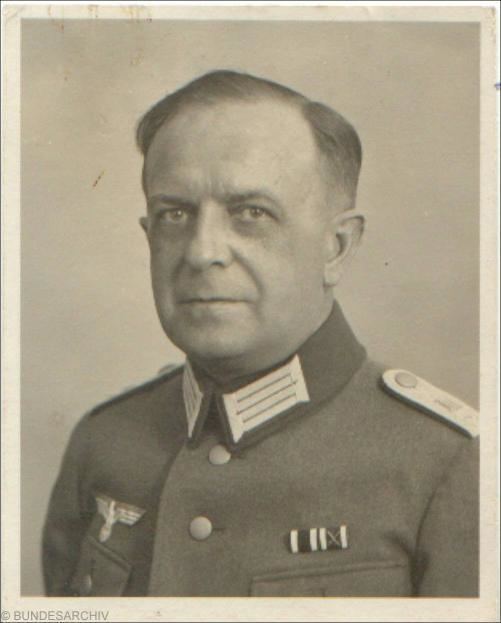Years of service 1914–181935–43 Awards Iron Cross Died 1943 | Name Theodor Hippel Service/branch German Army | |
 | ||
Born 19 January 1890 ( 1890-01-19 ) Commands held Lehr-Regiment Brandenburg z.b.V. 800 Battles/wars World War IWorld War IIInvasion of PolandBattle of FranceNorth African Campaign Battles and wars | ||
Dr. Theodor-Gottlieb von Hippel (19 January 1890 – 1 January 1977) was the German Army, and intelligence officer responsible for the formation and training of the Brandenburgers commando unit.
Contents
World War I
On October 18, 1914, shortly after the outbreak of the First World War, von Hippel volunteered for service in the Schutztruppe for German East Africa, where he served under General Paul von Lettow-Vorbeck in the East African theatre, where Lettow-Vorbeck had conducted a guerrilla campaign against Allied colonial troops. Von Hippel was promoted to Unteroffizier in August 1915 and was named an officer aspirant on February 17, 1916. He was promoted to Feldwebel on April 1, 1916, but was wounded and taken prisoner of war 5 days later on April 6. On returning from imprisonment in India on December 20, 1920, he was released from military service with the character of Leutnant der Reserve.
In 1922, von Hippel earned a doctorate in state economics (Dr. rer. cam., Doktor der Staatswirtschaftskunde) from the University of Tübingen. Von Hippel reentered the Army in 1935 as an Oberleutnant in Pionier-Bataillon Brandenburg an der Havel, and was promoted to Hauptmann later that year. On November 1, 1937, he was transferred to the Abwehr, the German military intelligence service.
World War II
Inspired by the example of Lettow-Vorbeck, Hippel proposed that small, élite units, highly trained in infiltration and sabotage and fluent in foreign languages, could operate behind enemy lines, wreaking havoc on the enemy’s command, communication and logistical chains. He approached the Reichswehr, where his unconventional idea was rejected. Hel then approached the commander of Abwehr, Admiral Wilhelm Canaris who accepted Hippel's idea. Hippel was assigned to Section II, the Abwehr branch dealing with clandestine operations. Since the project was top secret, this unit was designated "Special Duty Training and Construction Company" (Lehr und Bau Kompagnie) to mask its true function.
The unit's missions would be determined by the Oberkommando der Wehrmacht (OKW). The company was headquartered at Stendal in the old Prussian province of Brandenburg from whence it would derive its name. Here, at an old country estate on the city's outskirts, von Hippel's commandos were taught the techniques of stealth and self-sufficiency; how to move silently through the woods, to live off the land and navigate by the stars. They also learned to handle kayaks, skis and parachutes, and even how to create explosives from potash, flour and sugar.
The Brandenburgers did not attack without first revealing their true uniforms, which they wore underneath their disguises. This gave them the advantage, if captured, of being treated as uniformed enemy combatants rather than spies and thus being summarily executed. The company was expanded into a battalion, which was code named Ebbinghaus.
The Brandenburgers' first real test would come in mid-1939. Small teams of these commandos, disguised as miners and laborers, sneaked into Poland to begin infiltrating key factories, mines and power stations. The Germans now had a large, covert force of saboteurs deep behind Polish lines. The X-Day for Case White was set for September 1.
On the evening of August 31, a team of the Brandenburgers in civilian disguise prepared to go into action at Danzig. At 4:17 local time, they surrounded and attempted to seize the city's post office. A shootout then commenced between the commandos and armed postal workers which would last all day. This was, in effect, the opening engagement of the Second World War. Around the same time the old German battleship Schleswig-Holstein, supposedly in port on a "goodwill" visit, began shelling the city at point-blank range. The war started by bombing of the Polish town of Wielun, however there remains some debate on whether the war's first shots were fired by the Holstein or the Brandenburgers. But regardless, the Brandenburgers failed to capture the Post Office in the morning. It took a detachment of Schutzpolizei, elements of SS-Wachsturmbann "E" and SS-Heimwehr Danzig with several ADGZ armored cars to capture the Post Office after heavy fighting. After the defenders surrendered to the Germans in the evening of September 1, war crimes were committed on the Polish prisoners.
Simultaneously, the saboteur teams began to blow up their target facilities where they had been, up until then, employed. Meanwhile, other Brandenburgers slipped across the frontiers, infiltrated behind Polish defensive positions and seized crucial bridges across the river Vistula. At 5:00 AM local time on X-Day, the Panzer spearheads of five German armies would charge across these bridges. But von Hippel's Brandenburgers themselves had been the real spearheads for this first Blitzkrieg operation. fad Although Bataillon Ebbinghaus was disbanded at the end of the Polish campaign, they had performed well enough to be reconstituted, under their old Lehr und Bau Kompagnie codename, as a regiment in time to serve with distinction in the 1940 campaign in France and the low countries. By this time, Admiral Canaris had begun to push von Hippel aside and take a direct role in the Brandenburgers' operations himself. The unit continued to grow from a single regiment into one of the most feared and effective divisions fielded by Germany in World War II, participating on every front and in nearly every important campaign.
Von Hippel was promoted to Major on October 1, 1940 and to Oberstleutnant (Lieutenant Colonel) on June 1, 1941.
Von Hippel was sent to North Africa in February 1943, where he commanded a German-Arab unit in Tunis, and was captured by Allied troops when Axis resistance in Tunisia collapsed in May.
Post-war life
After the war, Hippel returned to Germany and in 1959 he was living in Emmingen ab Egg in Baden-Württemberg. He died on 1 January 1977 in Kiel at the age of 86.
